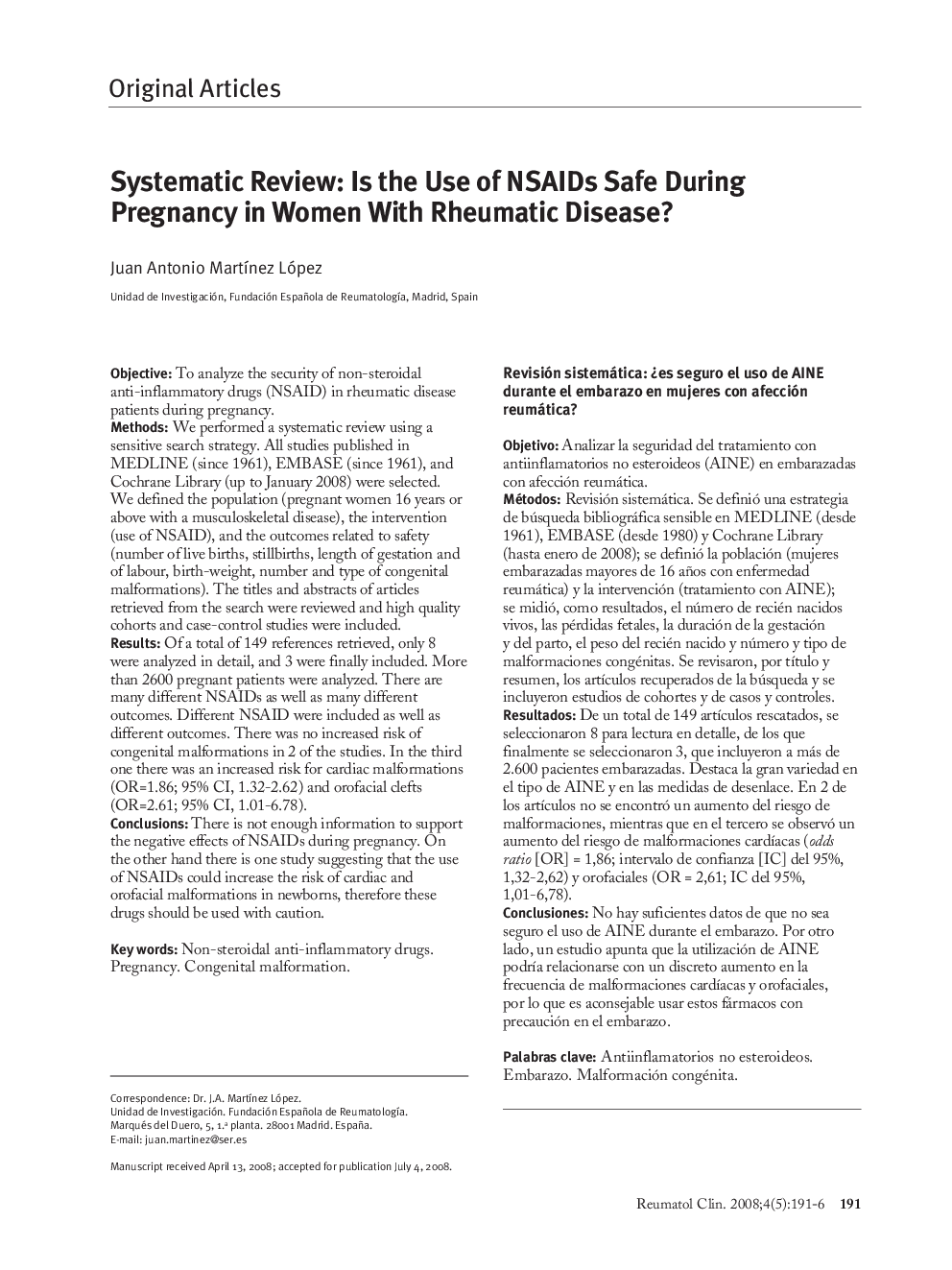| Article ID | Journal | Published Year | Pages | File Type |
|---|---|---|---|---|
| 3384881 | Reumatología Clínica (English Edition) | 2008 | 6 Pages |
ObjectiveTo analyze the security of non-steroidal anti-inflammatory drugs (NSAID) in rheumatic disease patients during pregnancy.MethodsWe performed a systematic review using a sensitive search strategy. All studies published in MEDLINE (since 1961), EMBASE (since 1961), and Cochrane Library (up to January 2008) were selected. We defined the population (pregnant women 16 years or above with a musculoskeletal disease), the intervention (use of NSAID), and the outcomes related to safety (number of live births, stillbirths, length of gestation and of labour, birth-weight, number and type of congenital malformations). The titles and abstracts of articles retrieved from the search were reviewed and high quality cohorts and case-control studies were included.ResultsOf a total of 149 references retrieved, only 8 were analyzed in detail, and 3 were finally included. More than 2600 pregnant patients were analyzed. There are many different NSAIDs as well as many different outcomes. Different NSAID were included as well as different outcomes. There was no increased risk of congenital malformations in 2 of the studies. In the third one there was an increased risk for cardiac malformations (OR=1.86; 95% CI, 1.32-2.62) and orofacial clefts (OR=2.61; 95% CI, 1.01-6.78).ConclusionsThere is not enough information to support the negative effects of NSAIDs during pregnancy. On the other hand there is one study suggesting that the use of NSAIDs could increase the risk of cardiac and orofacial malformations in newborns, therefore these drugs should be used with caution.
ObjetivoAnalizar la seguridad del tratamiento con antiinflamatorios no esteroideos (AINE) en embarazadas con afección reumática.MétodosRevisión sistemática. Se definió una estrategia de búsqueda bibliográfica sensible en MEDLINE (desde 1961), EMBASE (desde 1980) y Cochrane Library (hasta enero de 2008); se definió la población (mujeres embarazadas mayores de 16 años con enfermedad reumática) y la intervención (tratamiento con AINE); se midió, como resultados, el número de recién nacidos vivos, las pérdidas fetales, la duración de la gestación y del parto, el peso del recién nacido y número y tipo de malformaciones congénitas. Se revisaron, por título y resumen, los artículos recuperados de la búsqueda y se incluyeron estudios de cohortes y de casos y controles.ResultadosDe un total de 149 artículos rescatados, se seleccionaron 8 para lectura en detalle, de los que finalmente se seleccionaron 3, que incluyeron a más de 2.600 pacientes embarazadas. Destaca la gran variedad en el tipo de AINE y en las medidas de desenlace. En 2 de los artículos no se encontró un aumento del riesgo de malformaciones, mientras que en el tercero se observó un aumento del riesgo de malformaciones cardíacas (odds ratio [OR] = 1,86; intervalo de confianza [IC] del 95%, 1,32-2,62) y orofaciales (OR = 2,61; IC del 95%, 1,01–6,78).ConclusionesNo hay suficientes datos de que no sea seguro el uso de AINE durante el embarazo. Por otro lado, un estudio apunta que la utilización de AINE podría relacionarse con un discreto aumento en la frecuencia de malformaciones cardíacas y orofaciales, por lo que es aconsejable usar estos fármacos con precaución en el embarazo.
